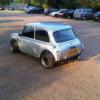
Indicator Speed
#1

Posted 08 May 2012 - 10:05 PM
Thanks
#2

Posted 08 May 2012 - 10:13 PM
#3

Posted 08 May 2012 - 10:20 PM
#4

Posted 08 May 2012 - 11:03 PM
I swapped both flasher units for relays and have reliable indicators.
#5

Posted 08 May 2012 - 11:06 PM
Edited by Alex_B, 08 May 2012 - 11:06 PM.
#6

Posted 09 May 2012 - 05:57 AM
#7

Posted 10 May 2012 - 06:21 PM
#8

Posted 10 May 2012 - 06:36 PM
Flasher unit will be on it's way out in all 3 cases. Change it for an indicator relay from the likes of Halfords etc, much more reliable and they flash at a steady rate. All you need to do is add an earth to the 3rd/spare terminal on the new relay.
Yes I agree get an elecctronic flasher unit, it's a quick and easy upgrade and they are much more reliable. This is what you need:
http://minispares.co...pid=36584
DO NOT buy any flasher units from Halfords though. They seem to be very poor quality and normally fail within a few minutes of being fitted.
#9

Posted 10 May 2012 - 10:20 PM
#10

Posted 11 May 2012 - 01:07 PM
#11

Posted 11 May 2012 - 03:11 PM
The indicator flasher relies on the resistance of the bulbs and wiring to control how fast the bimetallic strip inside it warms up & breaks the circuit to make it flash. If it's slow there's too much resistance, so check the earths and connections. Too fast means too little resistance, which might be a fused bulb or a short - give the wiring a once over in case it's the latter. Fitting an electronic flasher will correct the flashing but it won't fix the short if you have one.
Hazard flasher use an internal resistor so should always flash at the same rate, but there "default" position is with the flashers unlit which is why there are two units. Electronic flashers are used to do both jobs and are wired with an ignition switched relay (so you can't accidentally leave the indicators on), hence why calling Flasher units "relays" can be confusing.
1 user(s) are reading this topic
0 members, 1 guests, 0 anonymous users















